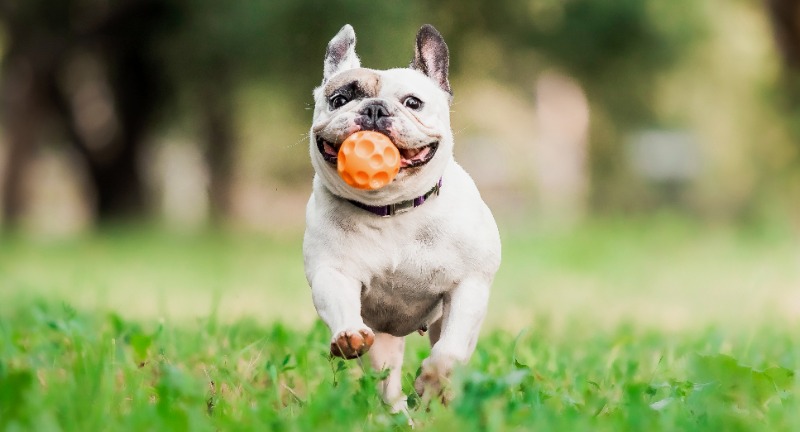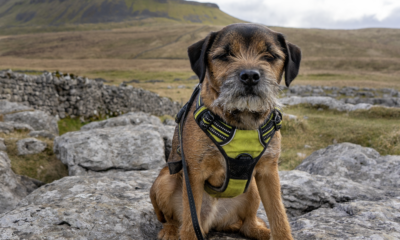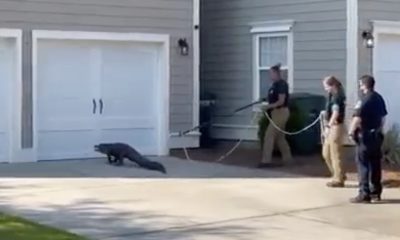NEWS
17 Easy Ways to Sharpen Your Dog’s Mind
Published
2 months agoon

Shutterstock
Dogs are more than just loyal companions; they’re natural learners with untapped potential waiting to be unlocked. Just like humans, dogs thrive on mental stimulation and benefit from activities that challenge their minds. Whether it’s learning new tricks, solving puzzles, or exploring the world, the right activities can significantly boost your dog’s intelligence. A smarter dog isn’t just a joy to live with, they’re happier, more confident, and better equipped to navigate life’s challenges.
Let’s take a look at 17 practical and fun ways that can help make your dog smarter, enhancing their mental agility and strengthening your bond.
Teach New Tricks Regularly

Shutterstock
Teaching your dog new tricks is one of the most effective ways to stimulate their brain. Start with the basics like “sit” and “stay,” then move on to advanced tricks like “roll over” or “play dead.” Dogs thrive on mental challenges, and learning new commands improves their focus and understanding. Keep the sessions short and rewarding to ensure your dog stays motivated and engaged.
Use Puzzle Toys

Shutterstock
Puzzle toys are fantastic for developing problem-solving skills in dogs. These toys require your dog to manipulate parts or solve puzzles to access a hidden treat. Not only do they keep your dog entertained, but they also improve their ability to concentrate and think critically. Make sure to choose a puzzle that matches your dog’s skill level and gradually increase the difficulty as they improve.
Socialize Your Dog

Shutterstock
Socializing your dog is crucial for developing their adaptability and intelligence. Regular interactions with other dogs and people help them learn new behaviors and understand social cues. A well-socialized dog is more confident and less prone to fear or anxiety in new situations. Take them to dog parks, training classes, or even just on walks in busy areas to broaden their experiences.
Rotate Toys Frequently

Shutterstock
Dogs can quickly lose interest in toys if they’re always the same. Rotating toys keeps their curiosity alive and prevents boredom. When you reintroduce an old toy after a few weeks, it feels new and exciting to your dog. This simple practice can make playtime more engaging and keep their minds sharp.
Practice Obedience Training

Shutterstock
Obedience training isn’t just about good behavior; it’s about improving your dog’s ability to understand and respond to commands. Regular training sessions reinforce focus and discipline, which are key components of intelligence. Start with foundational commands like “sit” and “stay,” then progress to advanced sequences. The process also strengthens the bond between you and your dog, making them more eager to learn.
Play Hide-and-Seek

Shutterstock
Hide-and-seek is a fun game that engages your dog’s problem-solving and tracking abilities. You can hide yourself, a favorite toy, or treats and encourage your dog to find them. This game stimulates their natural hunting instincts while providing mental and physical exercise. Plus, the thrill of discovery makes it a rewarding experience for them.
Introduce Agility Training

Shutterstock
Agility training is a perfect mix of physical and mental stimulation. Teaching your dog to navigate through obstacles like tunnels, jumps, and weave poles requires them to focus, think, and coordinate their movements. It’s an excellent activity for high-energy dogs and a fun way for you both to stay active. Start with simple setups at home and gradually increase the complexity as your dog masters the basics.
Take Different Walking Routes

Shutterstock
Walking the same route every day can become monotonous for your dog. Switching up the path exposes them to new smells, sights, and sounds, which stimulates their curiosity. Exploring different environments also helps them adapt to changes and learn how to navigate new spaces. It’s a small change that makes a big difference in keeping their mind sharp.
Teach Them Names of Objects

Shutterstock
Dogs can learn to associate words with objects, just like people do. Start with simple items like “ball” or “leash” and use repetition to teach them the names. Once they’ve learned a few, challenge them to retrieve the correct object based on your command. This practice enhances their memory and vocabulary, making them more attentive to your instructions.
Play Interactive Games

Shutterstock
Interactive games like tug-of-war or fetch require your dog to follow cues and strategize. These games enhance their decision-making skills and encourage cooperation. For example, in fetch, your dog has to retrieve the ball and return it to you for continued play. The key is to keep the games engaging and ensure they follow your commands to build focus and discipline.
Reward Problem-Solving

Shutterstock
Whenever your dog figures out how to solve a problem, such as opening a door or learning a new trick, reward them immediately. Positive reinforcement encourages them to try harder and learn faster. You can set up small challenges for your dog, like placing a treat under a cup and letting them figure out how to get it. These problem-solving opportunities make them more resourceful and confident.
Train in Different Environments

Shutterstock
Training in new environments challenges your dog to apply what they’ve learned in unfamiliar settings. Whether it’s a park, a friend’s house, or a busy street, these situations enhance their adaptability. The distractions in these places also test their focus and ability to stay attentive. Always start with basic commands and gradually increase the complexity of tasks.
Expose Them to New Experiences

Shutterstock
Taking your dog to new places, introducing them to different sounds, or exposing them to various textures keeps their senses sharp. New experiences challenge their ability to adapt and process unfamiliar stimuli. Whether it’s a car ride, a hike, or a trip to the beach, these outings provide a wealth of mental stimulation. They also build confidence and curiosity.
Train Impulse Control

Shutterstock
Impulse control is a critical part of canine intelligence. Teaching your dog to wait patiently for a treat or remain calm around distractions helps improve their self-discipline. Start with simple tasks like “leave it” or “wait,” then progress to more challenging scenarios. This skill not only makes your dog smarter but also better behaved.
Encourage Free Play

Shutterstock
Free play is essential for fostering creativity and independence in your dog. Allow them to explore the yard, sniff around, and interact with their environment without rigid instructions. This unstructured time lets them solve problems and make choices on their own. It’s a natural way to boost their confidence and mental agility.
Use Clicker Training

Shutterstock
Clicker training is an effective way to communicate with your dog. The click sound marks the exact moment your dog performs the desired behavior, making it easier for them to understand what you want. This clarity speeds up the learning process and enhances their focus. It’s a simple yet powerful tool for teaching complex behaviors.
Foster a Strong Bond

Shutterstock
Above all, a strong bond with your dog is the foundation for intelligence and learning. Dogs are more eager to learn when they feel loved and connected to their owners. Spend quality time with them through play, training, and cuddles to reinforce this bond. The trust and motivation they gain from your relationship will encourage them to explore and grow.
Conclusion

Shutterstock
Helping your dog become smarter is a rewarding journey that benefits both you and your furry friend. By incorporating mental challenges, physical activities, and new experiences into their routine, you’ll foster a well-rounded, confident, and adaptable companion. Remember, a smarter dog is also a happier dog, and the time spent engaging their mind strengthens the bond you share. Start small, stay consistent, and watch as your dog’s intelligence and enthusiasm grow with each new challenge.
More Amazing Animals+
-


The most beautiful thing you will watch today. Great #Hornbill…
-


27 Animals That Mate For Life
-


Triple otter on the rocks
-


25 Reasons Why Border Terriers Are the Ultimate Small Dog…
-


Kibble Goes Refillable: Pet Food Company Cracks Down On Waste…
-


25 Reasons to Love the Brussels Griffon
-


25 Breeds of Dogs That Are Perfect for First-Time Owners
-


Employee wrangles snake out of Disney World’s Magic Kingdom
-


25 Things That Make Weimaraners Such Loyal Companions
-


25 Things That Make Pharaoh Hounds Perfectly Exotic
-


Alligator arrest outside of a school in Charleston, SC
-


25 Things That Make Newfoundland Dogs Gentle Family Guardians
